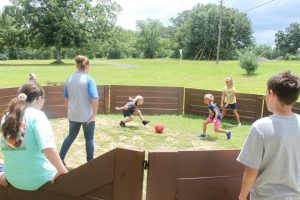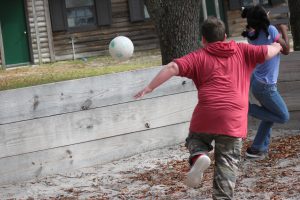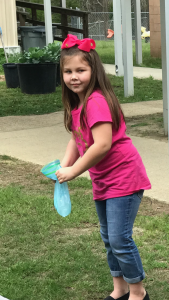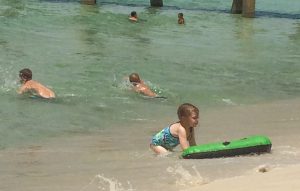by aschortinghouse | Jul 27, 2018
GAGA BALL
If your youth has attended 4-H Camp Timpoochee or Cherry Lake with the UF/IFAS 4-H Camping Program, they’ve had the chance to play GaGa Ball. You’re probably wondering what kind of name is GaGa ball. It’s not just a made-up name. GaGa ball has a rich history. GaGa is translated from Hebrew as “touch-touch”. It’s said to have originated in Israel, and it has become a popular game at camps around the United States. GaGa Ball is a version of dodgeball and is just as fun.
LET’S PLAY!
GaGa ball is not only fun to say, but it is really easy to learn. First, you need a place to play. GaGa ball is played in a GaGa pit. Here’s just one of many articles on how to build your own GaGa Ball Pit. Next, you need a ball. GaGa balls are not specific, although a heavy duty dodgeball is recommended. The rules of the game vary place to place, but we play by the following rules at 4-H Camp:

- You hit the ball with your hands only.
- If the ball hits you below the knee, you are out.
- If the ball bounces of the wall and hits you below the knee, you’re out.
- If you hit the ball out of the pit, you’re out.
- If you hit someone in the face, you’re out
- If the game is going slowly, the leader can call “Hands-In”.
Hands in means everyone who is already out can put their hands over the wall of the pit and try to get those still in the pit out.
Rules can be made and altered to fit the group that is playing the game although the first two rules are staples of the game.
WHAT’S THE BIG DEAL?

GaGa ball is a great way to expend extra energy during day camps, but it also is a great way to build and practice life skills. First off, youth are put in situations in every game where they have to practice decision making, discipline, resiliency and many other life skills 4-H strives to instill in our youth. Of course they have to practice their conflict resolution skills as there will inevitably conflicts that arise from their competitive natures. Most importantly, playing GaGa ball helps kids practice a healthy lifestyle. GaGa ball teaches many important lessons, and is a bunch of fun. So when you hear someone say, “Let’s play GaGa ball!”, give it a try and embrace the challenge.
Learn more about the history of GaGa Ball
by Whitney Cherry | Jul 13, 2018

You can see the skepticism on this young 4-H’ers face! Try this activity with your kids and see this same look change to amazement and laughter when ice cream really does come out!
That’s right! It’s National Ice Cream Day, and you know in 4-H we learn by doing. So let’s beat the summer heat and make some ice cream!
Ingredients
1 c. half-and-half
2 tbsp. sugar
1/2 tsp. pure vanilla extract
3 c. ice
1/3 c. kosher salt
Toppings of your choice
Directions
1. In a small Ziploc bag, combine half-and-half, sugar and vanilla. Push out excess air and seal.
2. Into a larger Ziploc bag, combine ice and salt.
3. Place small bag inside the bigger bag and shake vigorously, 7 to 10 minutes, until ice cream has hardened.
4. Remove from bag and enjoy with your favorite ice cream toppings.
I know this activity doesn’t seem to fall under the heading of healthy lifestyles, but it does support our dairy industry- bonus! – and it’s riddled with science concepts. You can talk to your youth about salt being a catalyst, why we have to shake the bag for it to be creamy, or the awesome invention of ziploc bags and how people come up with ideas like that- aka the engineering design process.
But more than this, every time you do something new with your kids, not only are you making memories and strengthening relationships, you are building their confidence too. They are mastering new skills and becoming more independent. They become excited about sharing their new knowledge and experiences which improves their communications skills. It’s a win-win-win!
So whether you’re home with your own kids, are helping with summer day camps, or are planning club kickoff meetings for the fall, try this easy activity with your 4-H members, and have fun. Because sometimes learning is fun!
by Melanie Taylor | Jul 8, 2018

Summer is here! As the long, hot days of summer move forward, there are many things to consider when it comes to children and water safety. Each summer we hear of tragic incidents of children drowning in pools, spas, and other bodies of water. These tragedies may be avoided by following a few simple tips to keep your child safe while letting them enjoy their summer break.
The U.S. Consumer Product Safety Commission (CPSC) is the agency charged with protecting the public from unreasonable risks of injury or death from thousands of types of consumer products under the agency’s jurisdiction. In addition to Pool and Spa Safety, the CPSC is committed to protecting consumers and families from products that pose a fire, electrical, chemical, or mechanical hazard. CPSC launched the campaign, PoolSafely.gov, which provides Pool Safely: Simple Steps to Save Lives, a national public education campaign to reduce childhood drownings, submersion injuries and entrapments. Review these tips below.
Tips from PoolSafely.gov and CPSC:
- Never leave a child unattended in or near water.
It is recommended to designate an official “Water Watcher”, this is an adult assigned with supervising the children in the water. This should be their only task – they should not be reading, texting or playing games on their phone. Have a phone close by at all times, in case you need to call for help, and if a child is missing, check the pool first. Even when a lifeguard is present, parents and caregivers should still take the responsibility of being a designated “Water Watcher”. When the lifeguard chair is empty, the other lifeguards may not be able to see the entire pool and when lifeguards are sitting in low chairs; other people in the pool can block their view.
- Teach children how to swim.
Swimming is fun, great exercise and it is a lifesaving skill, so why would you not instill this skill in your child? Be sure to enroll children in swimming lessons – the earlier the better. A few swimming lessons may just save their life.
- Teach children to stay away from pool drains.
Show your children where the pool drain is located and remind them of the dangers of those drains. Remind them not to play or swim near drains or suction outlets, especially in spas and shallow pools, and never enter a pool or spa that has a loose, broken or missing drain cover. Sadly, children’s hair, limbs, jewelry or bathing suits, etc. can get stuck in a drain or suction opening. When enjoying time in a spa, be sure to locate the emergency vacuum shutoff before getting in the water.
- Ensure all pools and spas – both in your backyard and any public pool you may visit – have compliant drain covers.
The powerful suction from a pool or spa drain can even trap an adult, let alone a child. The Pool and Spa Safety Act is named after Virginia Graeme Baker, a child that tragically died from drowning due to a suction entrapment from a faulty drain cover. Do to this act, it is now required by law that all public pools and spas must have drain grates or covers that meet safety standards to avoid incidents like the one that took Virginia’s life.
- Install proper barriers, covers and alarms on and around your pool and spa.
One of the biggest dangers with pools or spas is when they are left open without any proper fences, barriers, alarms and covers. Each of these can be lifesaving devices. A fence of at least four feet in height should surround the pool or spa on all sides and should not be made of a climbable material. The pool should only be accessible through a self-closing, self-latching gate. Teach children to never climb over a pool gate or fence. Always remove portable pool ladders when not in use, just so your child is not enticed to enter the water. It is also highly recommended to install a door alarm from the house to the pool area, and keep pool and spa covers in working order.
- Know how to perform CPR on children and adults.
CPR can be the reason a drowning victim survives. With all of the possible locations of CPR trainings, why not get CPR certified as an extra precaution in case there is a water emergency? CPR classes are available through many hospitals, community centers, or by contacting your local American Red Cross. Once certified, be sure to keep the certification up to date.
- Finally, take the Pledge!
Before heading to the water with your family, remember to take the Pool Safely Pledge. This online call to action is a reminder to stay safer around the water. This pledge for you and your child can be found at https://www.poolsafely.gov/pledge/. The pledge is supported by CPSC and the PoolSafely.gov initiative and Olympic swimmer Michael Phelps along with over 60,000 other pledge takers. Parents, you can also download coloring sheets and other fun PoolSafely.gov child friendly apps and songs.
With the large variety of water related summer activities available it does leave a chance for risky incidents. Some work and preparation ahead of time will make for a less anxious and more fun-filled summer. Planning for risk will lessen the high-risk stakes and make sure everyone is prepared in case of an emergency. So remember, Simple Steps Save Lives. Enjoy a safe, fun, and water filled time this summer!
Resources: For more information be sure to visit Pool Safely: Simple Steps Save Lives – https://www.poolsafely.gov




